AI in Business: The 2025 Roadmap
Introduction AI has moved from hype to necessity. Companies across all sectors are using machine learning (ML), natural language processing (NLP), computer vision, and generat...

Introduction
AI has moved from hype to necessity. Companies across all sectors are using machine learning (ML), natural language processing (NLP), computer vision, and generative AI to solve complex problems and achieve superior results. According to Deloitte’s State of AI 2024 report, 94% of business leaders believe AI will have a significant impact on their industry within the next two years.
In 2025, AI will be used not only for automation but also for real-time decision making, customer engagement, product development, and sustainability. It is no longer just a tool for innovation but a central driver of operational efficiency, customer engagement, and revenue generation. Companies are moving from experimenting with AI to deeply embedding it into their operations.
This paper provides a comprehensive roadmap for business leaders on how to prepare, adopt, and effectively scale AI capabilities in 2025. It covers trends, industry use cases, barriers, implementation strategies, management challenges, and practical recommendations, supported by real-world data and examples.
Market Overview and Adoption Statistics
Global AI market overview:
- Global AI market estimate in 2025: $407 billion (Statista)
- Compound annual growth rate (CAGR): 37.3%
- North America and Asia Pacific remain the two largest regions for AI spending, with China expected to surpass the US in some industrial applications.
- Industries with the largest AI investments include finance ($97 billion), healthcare ($83 billion), and retail ($72 billion).
- Funding for AI startups continues to grow, with global investment surpassing $120 billion in 2024, largely focused on core models, vertical AI solutions, and autonomous systems.
Enterprise AI Adoption (2025):
- Percentage of enterprises using AI in at least one core business function: 84%
- Organizations reporting measurable business performance improvements from AI: 63%
- Average productivity gains from AI: 20-40% depending on industry and maturity level (PwC)
Department-level adoption:
- Customer service: 76% use AI-powered chatbots and natural language processing tools
- Marketing: 68% use AI for predictive analytics and customer segmentation
- HR: 51% use AI for candidate screening and employee sentiment analysis
- Finance: 58% use AI for fraud detection and financial forecasting
- Operations: 63% use AI in supply chain and process automation
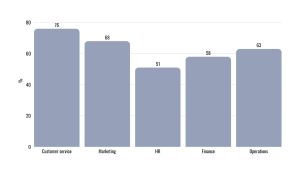
Key growth drivers
- The explosion of big data
- Advances in computing power and cloud infrastructure
- Improved AI/ML algorithms
- Increasing demand for automation and efficiency
Top AI-adopting sectors in 2025:
- Financial services
- Healthcare
- Manufacturing
- Retail
- Transportation and logistics

Key AI Trends Shaping 2025
1. Generative AI at Scale
Generative AI applications are transforming content creation, software development, customer service, and more. Enterprises are moving away from third-party tools to developing their own core models, enabling domain-specific generative capabilities. Use cases include synthetic data generation, automated product descriptions, and AI pilots for employees.
2. Hyper-Personalization
AI now tailors experiences in real time using advanced recommender systems and behavioral analytics. In 2025, hyper-personalization is no longer limited to B2C giants. Banks, insurance companies, and e-learning platforms offer customized pricing, product packages, and learning paths based on predictive modeling.
3. Autonomous Decision Making
AI systems are increasingly capable of acting without human intervention in predefined scenarios. Examples include dynamic pricing algorithms in e-commerce, AI-powered investment decisions in fintech, and real-time threat detection in cybersecurity. These autonomous systems use reinforcement learning, causal inference, and adaptive neural networks.
4. Democratizing AI
Low-code/no-code tools, AutoML, and pre-trained models from major cloud AI platforms (e.g., AWS SageMaker, Google Vertex AI) provide broader access to AI capabilities. Business units can now experiment and deploy AI solutions with minimal IT involvement, resulting in faster innovation cycles.
5. Responsible and Regulated AI
The push for responsible AI has become institutionalized. In 2025, companies are expected to meet regulatory standards for fairness, explainability, and transparency. AI audits and risk assessments are mandatory for a number of governments. Companies are adopting AI ethical charters, algorithm impact assessments, and bias-mitigation tools as part of operational compliance.
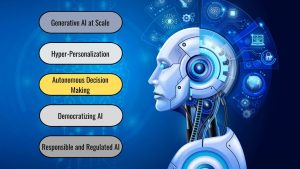
Industry Applications
Healthcare
- AI-powered diagnostics reduce human errors in radiology and pathology.
- Predictive models help identify high-risk patients and guide preventive treatment.
- Virtual assistants manage appointment scheduling and post-treatment monitoring.
- Clinical trials are accelerated with AI-powered patient recruitment and synthetic control groups.
Retail and eCommerce
- AI personalizes customer interactions in real-time with dynamic offers and customized search results.
- Inventory optimization algorithms reduce overstocks and stockouts, while demand forecasting improves purchasing accuracy.
- Visual recognition and augmented reality tools allow customers to virtually preview products, increasing conversion rates.
- Generative AI is used to automatically generate product descriptions, reviews, and marketing content.
Finance
- AI-powered algorithms enable fraud detection, compliance, credit scoring, and algorithmic trading.
- Virtual financial advisors provide personalized 24/7 customer support and portfolio recommendations.
- Natural language models are used to analyze financial documents and requests for investment signals.
Manufacturing and logistics
- Predictive maintenance and AI-powered sensors prevent downtime and extend equipment life.
- Computer vision robotics improve manufacturing accuracy and efficiency.
- Dynamic routing and fleet management optimize delivery operations using real-time data from IoT devices.
- AI is also used for defect detection and real-time quality control on assembly lines.

Challenges and Barriers to Adoption
- Talent shortage: 67% of companies report difficulty hiring qualified AI professionals, including machine learning engineers, data scientists, and AI ethicists. The skills gap is most acute in midsize companies and emerging economies.
- Data quality and integration: 59% of organizations struggle with legacy systems, unstructured data, and fragmented data silos. Without clean, accessible data, AI systems perform poorly or generate misleading insights.
- Cost of implementation: 48% cite budget constraints and difficulty demonstrating short-term ROI. AI projects can be resource-intensive, especially when building custom models or integrating with existing systems.
- Ethical concerns and risk management: 42% of companies are concerned about potential reputational damage due to biased or opaque AI decisions. Regulations are changing rapidly, and non-compliance can lead to fines and disruption.
- Organizational resistance: 39% report internal resistance from departments unwilling to embrace change. This includes concerns about job losses, lack of trust in algorithms, and resistance from management unfamiliar with the potential of AI.
Successful organizations mitigate these challenges through strategic investments in training, change management, cross-functional AI governance teams, and phased implementation models that start with clear, high-impact use cases.
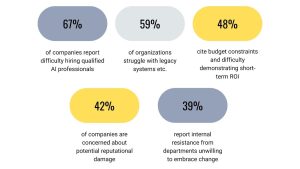
Building an AI-Ready Enterprise
Organizations looking to scale AI must address both technical and cultural challenges. Here’s how:
- Invest in AI infrastructure. Deploy scalable cloud platforms with GPU/TPU acceleration. Use MLOps tools for lifecycle management.
- Develop AI literacy and upskilling. Provide continuous training programs for AI, data analytics, and ethics. Upskill non-technical employees to effectively use AI tools.
- Build cross-functional AI teams. Bring together subject matter experts, data scientists, software engineers, and ethicists. Break down silos between IT and the business.
- Embrace Agile and experimentation. Use MVPs and pilots to test and iterate quickly. Develop a culture of testing and learning.
- Align AI with business strategy. Focus AI initiatives on tangible results such as revenue growth, cost savings, or customer satisfaction.
- Implement Data Governance. Establish data governance, quality checks, and provenance.

Governance, Ethics, and Regulation
AI governance has become a critical area of focus in 2025. Businesses must proactively address regulatory and ethical issues to ensure the safe and responsible use of AI.
Regulatory Environment
The EU AI Act, expected to come into effect in 2025, classifies AI systems by risk level and requires transparency, accountability, and human oversight.
The US AI Executive Order requires companies to disclose safety test results and sets standards for privacy, cybersecurity, and anti-bias.
Ethical Principles
- Fairness: Avoid algorithmic bias in hiring, lending, and sentencing.
- Transparency: Make AI decisions clear to users.
- Accountability: Assign responsibility for AI results.
- Privacy: Ensure AI systems comply with data protection laws like GDPR and CCPA.
Internal Governance
- Creating AI ethics boards or committees
- Using third-party audits for high-performing models
- Creating risk assessment protocols
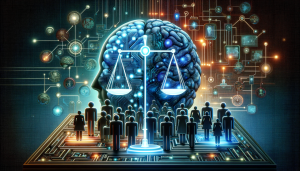
Use Cases
BMW Group
BMW integrated AI into its predictive maintenance systems and visual inspection processes on its production lines.
- Challenge: Machine downtime and manual inspection errors
- Solution: Deep learning-based computer vision systems were deployed to detect defects; IoT sensors and machine learning models were used for predictive maintenance.
- Results: Reduced machine downtime by 30%, improved defect detection accuracy by 20%, and enabled real-time decision making on production lines.
JPMorgan Chase
JPMorgan deployed natural language processing (NLP) models in its legal, compliance, and customer service departments.
- Challenge: High labor costs and long turnaround times for reviewing complex legal documents
- Solution: Applying NLP to analyze contracts and automate responses to customer inquiries
- Results: Saved 360,000 hours of legal time per year, reduced customer service response time by 35%, and reduced risk of non-compliance.
Walmart
Walmart deployed AI to improve store and supply chain efficiency.
- Challenge: Inventory management and long checkout lines
- Solution: Used AI-powered computer vision to track shelf stock and customer movement; deployed AI to forecast demand and automatically replenish inventory.
- Results: Increased product availability by 25%, reduced out-of-stocks by 30%, and reduced average customer wait time at checkout by 40%.
Strategic Roadmap for 2025 and Beyond
A future-ready AI strategy is a dynamic project that aligns business goals with evolving AI capabilities. Here’s a detailed strategic approach to help businesses leverage AI in 2025 and beyond:
1. Vision and Alignment
- Define your AI ambitions – whether that’s operational efficiency, customer experience, product innovation, or all three.
- Ensure your AI goals are aligned with your overall business strategy.
- Identify stakeholders and establish leadership.
2. Data and Technology Readiness
- Audit your current data assets and infrastructure.
- Invest in scalable cloud platforms and data lakes.
- Implement robust data governance frameworks.
3. Identify and Prioritize Use Cases
- Start with high-impact, simple use cases to build confidence.
- Create a centralized use case repository.
- Assess success metrics like ROI, customer satisfaction, or time savings.
4. Develop Talent and Culture
- Upskill existing teams through training and certification.
- Hire AI specialists, but also focus on cross-disciplinary roles.
- Develop a culture of experimentation and innovation.
5. Develop and Deploy Models
- Use agile, iterative development methodologies (e.g. MLOps).
- Build cross-functional AI teams.
- Monitor models after deployment for drift, performance, and bias.
6. Ethics, Risk, and Compliance
- Create an AI Ethics Board.
- Ensure transparency across all AI models.
- Implement continuous auditing and risk assessment.
7. Scale and Innovate
- Move from pilot to scale by building reusable AI components and APIs.
- Foster internal and external innovation through hackathons, partnerships, and AI incubators.
- Monitor emerging trends such as edge AI, neural symbolic AI, and quantum AI.
This roadmap is iterative. Enterprises should frequently reassess and adapt their AI strategy based on new capabilities, feedback, and market changes.
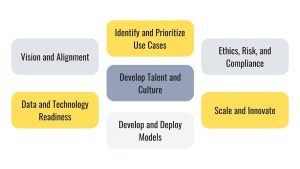
Top AI Predictions for 2026
AI-powered decision making is becoming the norm
By 2026, more than 90% of enterprise strategies will be based on AI-generated insights. Decision Intelligence platforms will be embedded across departments, from finance to HR to product development, helping executives model outcomes, optimize performance, and mitigate risk in real time.
Enterprise-level adoption of generative AI
Generative AI will expand beyond marketing and content creation to impact R&D, product prototyping, code generation, and supply chain planning. Most mid- to large-sized enterprises will deploy internal generative AI models trained on proprietary data, emphasizing data privacy and intellectual property control.
AI legislation will tighten globally
The EU AI Act will see similar frameworks emerge in the US, India, and parts of Asia Pacific. Companies will be required by law to implement bias audits, explainability tools, and AI impact assessments, especially in sectors such as healthcare, insurance, finance, and education.
AI agents will transform workflows
Autonomous AI agents – task-focused bots that can reason, plan, and act – will automate complex workflows in customer service, procurement, and internal support. Gartner predicts that 25% of enterprises will use AI agents across multiple business units by 2026.

AI ethics and brand trust will become a competitive advantage
As public awareness of the risks of AI increases, companies will prioritize ethical AI as part of their brand strategy. Companies with transparent, fair, and accountable AI systems will enjoy stronger customer loyalty and a reputational advantage.
Democratization of AI will accelerate
With no-code/low-code platforms and pre-trained models, AI will become increasingly accessible to non-technical users. Citizen data scientists and business analysts will build and deploy AI-powered tools with minimal IT support.
Cross-industry AI platforms will grow
AI capabilities will become more horizontal, with platforms offering plug-and-play tools that work across industries. They will include modular AI components for prediction, personalization, anomaly detection, and natural language processing, accelerating AI adoption for small businesses.
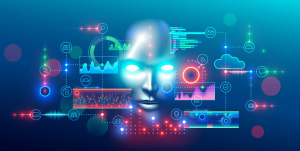
Conclusion
AI in 2025 is no longer experimental – it is transformative. The companies that will thrive will be those that act now, using AI not just as a tool but as a core element of their strategic identity.
The opportunities are vast, from operational efficiency to market leadership, from personalized experiences to predictive intelligence. But success depends on a clear roadmap, leadership alignment, a strong data foundation, ethical governance, and a culture of innovation.
Now is the time to take bold steps. Start with small wins, but plan big. Train your teams. Build responsible AI systems. Invest in the right partnerships and platforms.
Let this whitepaper be your launchpad. Whether you’re just starting out or looking to scale, the AI-powered future starts with the decisions you make today.
Act now. Lead the change. Shape the future.